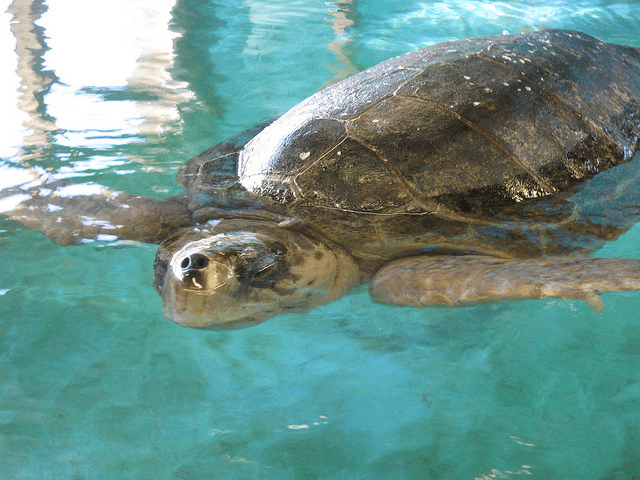Which Species Should We Save?
Situated near the center of Jekyll Island is one of Georgia's most well-known and celebrated conservation programs, the Georgia Sea Turtle Center (GSTC). Since opening in 2007, the GSTC has taken in over 300 injured sea turtles as patients and, impressively, most of them have been released back into the ocean.

Also notable, in 2013, the GSTC managed a revenue stream of almost $1.3 million; according to the GSTC website, these funds go toward educating the public on the coastal environment and its stewardship, as well as the activities and operations that go into preserving endangered sea turtles (among other coastal species). While definitely a noble endeavor, this does raise the question of whether largely focusing on one or a small handful of species is an effective way to conserve and protect the environment, particularly if those species are being targeted because they are cute or fascinating to humans.
There tends to be a bias in which species are protected: cute, cuddly, and charismatic over creepy, crawly, and plant-like. But, what about pollinators and decomposers – organisms, which are often insects, that have a profound impact on their ecosystems and our way of life? There are 3.4 million species of insects, but only about 1200 have had their conservation status evaluated; about half of those are at risk of extinction. Perhaps it is wiser to focus on species that are essential to the environment.
Justifying a conservation program
The conservation of sea turtles would make more sense if the health of their environment hinges on their survival. While six of the seven species are considered vulnerable or worse (meaning that they are at risk of becoming endangered or extinct in the near future), sea turtles may still be an important player in their ecosystems.

One study found that ~14,000 turtle nests transported similar quantities of energy and nutrients, which come from undeveloped eggs or eaten hatchlings, to the beach's dunes as other important biological transporters (e.g. marine carrion, surf diatoms). This helps maintain dune plant communities, which in turn helps prevent beach erosion and all the benefits of beaches, like barriers against storm surges, the maintenance of species-rich ecosystems, and vacation spots.
All in all, the argument could be made that focusing conservation efforts largely on sea turtles could lead to benefits for the overall environment and economy. However, invasive species, uncontrolled development, and litter may be greater problems, in which case other efforts probably should be prioritized.
What about other species that receive large amounts of focus and money – do they produce the same benefits? This question has mainly focused on one well-known, and cute, species: the giant panda.
One very cute, and very expensive, critter
Only about 1800 pandas remain in the world and their future is perilous. They are finicky eaters, are not adapted to the food they eat (i.e. bamboo), and are not huge fans of procreating.
Conservation efforts have focused on breeding programs in zoos and reserves, though native habitat is still threatened and reintroduction experiments have been slow. Caring for pandas in zoos is also astronomically expensive: the zoo in Edinburgh recently rented two pandas from China at £600,000 (about $947,000) a year for 10 years; it costs about £100,000 to import bamboo shoots. Zoos in Washington, Atlanta, Memphis, and San Diego have spent about $33 million more on pandas (from 2000-2003) than they received from showing them. This is money that could be well spent on protecting other species or habitat reconstruction.
So, are there any reasons to save them?
Pandas are, by and large, the face of wildlife conservation efforts; almost by instinct, looking at a panda invokes thoughts of protecting the environment. At the very least, they serve a symbolic purpose and help raise millions every year for other species and conservation efforts.

In addition, a recent study found that most panda habitat coincides with other endemic and threatened species' habitat, thus allowing pandas to serve as a ‘protection umbrella' for them. Despite the difficulties in conserving the species, pandas are probably worth saving. However, they do provide a good thought exercise in how conservation efforts should be handled.
Should we invest so much in a species that has little chance of surviving? What if that species brings in huge amounts of money that can be diverted towards saving other species? What are the most effective ways to utilize the limited resources we have in conserving the Earth?
About the Author
 A transplant from Virginia (Hoos!), Greg Evans is a graduate student in the Plant Biology department at the University of Georgia studying defense tradeoffs in morning glories. When he's not tangled up in weeds, Greg enjoys Ultimate Frisbee, bowling, and board games. He can be reached at gevans@uga.edu. More from Greg Evans. A transplant from Virginia (Hoos!), Greg Evans is a graduate student in the Plant Biology department at the University of Georgia studying defense tradeoffs in morning glories. When he's not tangled up in weeds, Greg enjoys Ultimate Frisbee, bowling, and board games. He can be reached at gevans@uga.edu. More from Greg Evans. |
About the Author
- athenssciencecafehttps://athensscienceobserver.com/author/athenssciencecafe/April 17, 2020
- athenssciencecafehttps://athensscienceobserver.com/author/athenssciencecafe/April 12, 2020
- athenssciencecafehttps://athensscienceobserver.com/author/athenssciencecafe/April 3, 2020
- athenssciencecafehttps://athensscienceobserver.com/author/athenssciencecafe/March 30, 2020







